User:HistoryofIran/Rostam Farrokhzad
| This is a Wikipedia user page. This is not an encyclopedia article or the talk page for an encyclopedia article. If you find this page on any site other than Wikipedia, you are viewing a mirror site. Be aware that the page may be outdated and that the user in whose space this page is located may have no personal affiliation with any site other than Wikipedia. The original page is located at http://en.wikipedia.org/wiki/User:HistoryofIran/Rostam_Farrokhzad. |
Rostam Farrokhzad | |
|---|---|
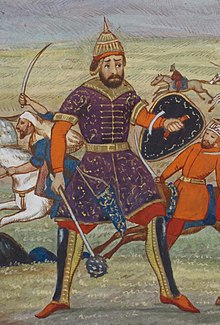 17th-century Shahnameh illustration of Rostam Farrokhzad | |
| Died | 19 November 636 al-Qadisiyyah |
| Allegiance | Sasanian Empire |
| Commands | Spahbed of Adurbadagan (631–636) |
| Battles / wars | Battle of al-Qadisiyyah |
| Relations | Farrukh Hormizd (father) Farrukhzad (brother) |
Rostam Farrokhzād (Persian: رستم فرخزاد) was an Iranian dynast from the Ispahbudhan family, who served as the spahbed ("military marshal") of the northwestern quarter (kust) of Adurbadagan during the reign of Boran (r. 630–630, 631–632) and Yazdegerd III (r. 632–651). Rostam is remembered as a historical figure, a character in the Persian epic poem Shahnameh ("Book of Kings"), and as a touchstone of most Iranian nationalists.
Background
[edit]Rostam was a member of the House of Ispahbudhan, one of the Seven Great Houses of Iran, which formed the elite aristocracy of the Sasanian Empire; the family traced its descent back to military marshals (spahbed), and occupied important offices in the realm.[1] According to a romanticized legend about their origin, a daughter of the Parthian/Arsacid king Phraates IV (r. 37–2 BC), named Koshm, married a "general of all Iranians"; their offspring bore the title of "Aspahpet Pahlav", later forming the Ispahbudhan clan.[2] Through their Arsacid lineage, the Ispahbudhan claimed to be descendants of Darius III and Esfandiyar.[3]
Under the Sasanians, the Ispahbudhan enjoyed such a high status that they were acknowledged as "kin and partners of the Sasanians".[3] Indeed, Rostam's father Farrukh Hormizd was the first-cousin of the Sasanian King of Kings (shahanshah) Khosrow II (r. 590–628), while his great-grandfather Shapur was the first cousin of shahanshah Khosrow I (r. 531–579).[1] Although the hereditary homeland of the Ispahbudhan seems to have been Khorasan, the family in the course of time came to rule the northwestern quarter (kust) of Adurbadagan (not to be confused with the namesake province of Adurbadagan). Rostam's birthplace is hence reported to be in Armenia, Adurbadagan, Hamadan, or Ray.[1] Rostam had a brother named Farrukhzad, who was active in Ctesiphon and enjoyed a great status there, reportedly being a favourite of Khosrow II.[4]
War with the Byzantine Empire
[edit]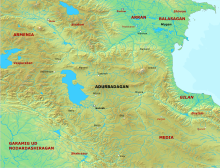
In 602, the Byzantine emperor Maurice (r. 582–602) was murdered by his political rival Phocas. As a result, Khosrow II proceeded to declare war, ostensibly to avenge the death of Maurice. During the two decade war, Khosrow was initially successful, conquering the Roman provinces in the Near East, including Egypt.[5] During the third phase of the war (624), however, the tables turned heavily, with Heraclius conquering Transcaucasia, thus leaving the northwestern Sasanian realm exposed.[6] During this period, many Iranian grandees became dissatisfied with the rule of Khosrow II, not only due to the Byzantine victories but also his policies.[7]
This included Rostam, who at the head of 10,000 soldiers, rebelled in the Adurbadagan province. Around the same time, Heraclius invaded Adurbadagan, sacking the city of Ganzak.[6] The modern historian Parvaneh Pourshariati proposes two possibilities behind the success of Heraclius' invasion of Adurbadagan; one being that the significance of the rebellion allowed him to attack the province; the other being that Farrukh Hormizd stopped supporting Khosrow II, as a result allowing Heraclius to attack Adurbadagan.[8] By 627, the distinguished Mihranid general Shahrbaraz had mutinied, while Farrukh Hormizd secretly conspired with him against Khosrow II.[9] The following year, Khosrow II was overthrown by several powerful factions within the empire, which included; Shahrbaraz, who represented the Mihran family; the House of Ispahbudhan represented by Farrukh Hormizd and his two sons Rostam and Farrukhzad; the Armenian faction represented by Varaztirots II Bagratuni; and the Kanarang.[10] The factions installed Khosrow II's son Kavad II on the throne, who soon had his father executed.[5]
Civil war in Iran
[edit]Reign of Kavad II, Ardashir III and Shahrbaraz
[edit]The fall of Khosrow II culminated in the Sasanian civil war of 628–632, with the most powerful members of the nobility gaining full autonomy and starting to create their own government. The hostilities between the Persian (Parsig) and Parthian (Pahlav) noble-families were also resumed, which broke up the wealth of the nation.[11] A few months later, the devastating Plague of Sheroe swept through the western Sasanian provinces. Half the population, including Kavad II himself, perished.[11] He was succeeded by his eight-year-old son, who became Ardashir III. Ardashir's ascension was supported by both the Pahlav, Parsig, and a third major faction named the Nimruzi.[12] However, sometime in 629, the Nimruzi withdrew their support for the king, and started to conspire with the distinguished Iranian general Shahrbaraz to overthrow him.[13] The Pahlav, under their leader Farrukh Hormizd, began supporting Khosrow II's daughter Boran as the new ruler of Iran, who subsequently started minting coins in the Pahlav areas of Amol, Nishapur, Gurgan and Ray.[13] On 27 April 630, Ardashir III was killed by Shahrbaraz,[14] who in turn was murdered, after a reign of forty days, in a coup by Farrukh Hormizd.[15] Farrukh Hormizd then helped Boran ascend the throne, sometime in late June 630.[16]
Reign of Boran, Shapur-i Shahvaraz and Azarmidokht
[edit]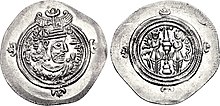
Boran's accession was most likely due to her being the only remaining legitimate heir of the empire able to rule, along with her sister Azarmidokht.[17] However, she was deposed in 630, and Shapur-i Shahrvaraz, the son of Shahrbaraz and a sister of Khosrow II, was made ruler of Iran.[18] When he was not recognized by the Parsig faction of the powerful general Piruz Khosrow, he was deposed in favor of Azarmidokht.[19] Farrukh Hormizd, in order to strengthen his authority and create a harmonious modus vivendi between the Pahlav and Parsig families, asked Azarmidokht (who was a Parsig nominee) to marry him.[20] Not daring to refuse, she had him killed with the aid of the Mihranid aristocrat Siyavakhsh, who was the grandson of Bahram Chobin, the famous military commander and briefly monarch of Iran.[21] Rostam, who was at that time stationed in Khorasan, succeeded him as the leader of the Pahlav. In order to avenge his father, he left for Ctesiphon, in the words of the 9th century historian Sayf ibn Umar, "defeating every army of Azarmidokht that he met".[22] He then defeated Siyavakhsh's forces at Ctesiphon and captured the city.[22] Azarmidokht was shortly afterwards blinded and killed by Rostam, who restored Boran to the throne in June 631.[23][24] Boran complained to him about the state of the empire, which was at that time in a state of frailty and decline. She reportedly invited him to administer its affairs, and so allowed him to assume overall power.[22]
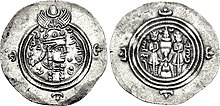
A settlement was reportedly made between the family of Boran and Rostam: according to Sayf, it stated that the queen should "entrust him [i.e., Rostam] with the rule for ten years,” at which point sovereignty would return "to the family of Sasan if they found any of their male offspring, and if not, then to their women".[22] Boran deemed the agreement appropriate, and had the factions of the country summoned (including the Parsig), where she declared Rostam as both the leader of the country and its military commander.[22] The Parsig faction agreed, with Piruz Khosrow being entrusted to administer the country alongside Rostam.[25]
The Parsig agreed to work with the Pahlav because of the fragility and decline of Iran, and also because their Mihranid collaborators had been temporarily defeated by Rostam.[25] However, the cooperation between the Parsig and Pahlav would prove short-lived, due to the unequal conditions between the two factions, with Rostam's faction having a much more significant portion of power under the approval of Boran.[25] In the following year a revolt broke out in Ctesiphon. While the imperial army was occupied with other matters, the Parsig, dissatisfied with the regency of Rostam, called for the overthrow of Boran and the return of the prominent Parsig figure Bahman Jaduya, who had been dismissed by her.[26] Boran was killed shortly after; she was presumably strangled by Piruz Khosrow.[26][27] Hostilities were thus resumed between the two factions.[26] Not long afterwards, both Rostam and Piruz Khosrow were threatened by their own men, who had become alarmed by the declining state of the country.[28] Rostam and Piruz Khosrow thus agreed to work together once more, installing Boran's nephew Yazdegerd III (r. 632–651) on the throne, and so putting an end to the civil war.[28]
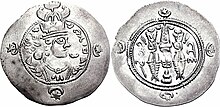
Accession of Yazdegerd III and end of the civil war
[edit]Yazdegerd was crowned in the Anahid fire-temple in Istakhr, where he had been hiding during the civil war. The temple was the very place where the first Sasanian shahanshah Ardashir I (r. 224–242) had crowned himself, indicating that the reason behind Yazdegerd's coronation at the same place was due to hopes for a rejuvenation of the empire.[29] He was almost the last living member of the House of Sasan.[30] Most scholars agree that Yazdegerd was eight years old at his coronation.[11][31][32] At his accession, he assigned Rostam with the defense of the empire, telling him "Today you are the [most prominent] man among the Persians."[33] Although being acknowledged as the rightful monarch by both the Parsig and Pahlav factions, Yazdegerd did not seem to have held sway over all of his empire. Indeed, during the first years of his rule coins were only minted in Pars, Sakastan, and Khuzestan, approximately corresponding to the regions of the southwest (Xwarwarān) and southeast (Nēmrōz), where the Parsig was based.[34] The Pahlav, who were mainly based in the northern portion of the empire, refused to mint coins of him.[34]
War with the Muslims
[edit]It has even been proposed that Rostam may have been killed by his own men, as an act of vengeance for killing Azarmidokht.[35]
Legacy and assessment
[edit]Rostam was remembered as the last leader of Sasanian Iran, with no one to fill the vacuum left by him.[36] Rostam's brother Farrukhzad honored his memory, stating that "[t]here was no knight in all the world like Rostam, no wise man had ever heard of his equal."[37]
Family tree
[edit]
|
King of Kings |
|
King | ||||||||||||
| Bawi | |||||||||||||||||||||||||||||||||||||||||||||||||||
| Shapur | |||||||||||||||||||||||||||||||||||||||||||||||||||
| Vinduyih | Vistahm | ||||||||||||||||||||||||||||||||||||||||||||||||||
| Farrukh Hormizd | Tiruyih | Vinduyih | |||||||||||||||||||||||||||||||||||||||||||||||||
| Rostam Farrokhzad | Farrukhzad | ||||||||||||||||||||||||||||||||||||||||||||||||||
| Shahram | Surkhab I | Isfandyadh | Bahram | Farrukhan | |||||||||||||||||||||||||||||||||||||||||||||||
References
[edit]- ^ a b c Lewental 2017b.
- ^ Pourshariati 2008, pp. 26–27.
- ^ a b Shahbazi 1989, pp. 180–182.
- ^ Pourshariati 2008, p. 147.
- ^ a b Howard-Johnston 2010.
- ^ a b Pourshariati 2008, p. 149.
- ^ Pourshariati 2008, pp. 146–173.
- ^ Pourshariati 2008, p. 152.
- ^ Pourshariati 2008, pp. 149–151.
- ^ Pourshariati 2008, p. 173.
- ^ a b c Shahbazi 2005.
- ^ Pourshariati 2008, pp. 178, 209.
- ^ a b Pourshariati 2008, p. 209.
- ^ Pourshariati 2008, pp. 181, 209.
- ^ Pourshariati 2008, pp. 182–3.
- ^ Pourshariati 2008, pp. 185, 205.
- ^ Daryaee 2014, p. 36.
- ^ Pourshariati 2008, pp. 204–205.
- ^ Pourshariati 2008, p. 204.
- ^ Pourshariati 2008, pp. 205–206.
- ^ Pourshariati 2008, pp. 206, 210.
- ^ a b c d e Pourshariati 2008, p. 210.
- ^ Pourshariati 2008, pp. 209–210.
- ^ Gignoux 1987, p. 190.
- ^ a b c Pourshariati 2008, p. 211.
- ^ a b c Pourshariati 2008, p. 218.
- ^ Daryaee 2018, p. 258.
- ^ a b Pourshariati 2008, p. 219.
- ^ Daryaee 2010, p. 51.
- ^ Frye 1983, p. 171.
- ^ Kia 2016, p. 284.
- ^ Pourshariati 2008, p. 257.
- ^ Lewental 2017a, p. 257.
- ^ a b Pourshariati 2008, pp. 221–222.
- ^ Lewental 2017a, p. 229.
- ^ Lewental 2017a, pp. 227, 233.
- ^ Lewental 2017a, p. 233.
Sources
[edit]- Daryaee, Touraj (2010). "When the End is Near: Barbarized Armies and Barracks Kings of Late Antique Iran". Ancient and Middle Iranian studies: proceedings of the 6th European Conference of Iranian Studies, held in Vienna, 18–22 September 2007. Vol. Iranica. Harrassowitz. pp. 43–52. ISBN 9783447064224.
- Daryaee, Touraj (2014). Sasanian Persia: The Rise and Fall of an Empire. I.B.Tauris. ISBN 978-0-85771-666-8.

- Daryaee, Touraj (2018). "Boran". In Nicholson, Oliver (ed.). The Oxford Dictionary of Late Antiquity. Oxford: Oxford University Press. ISBN 978-0-19-866277-8.
{{cite encyclopedia}}: Invalid|ref=harv(help) - Frye, R. N. (1983), "Chapter 4", The political history of Iran under the Sasanians, The Cambridge History of Iran, vol. 3, Cambridge University Press, ISBN 978-0-521-20092-9
- Gignoux, Ph. (1987). "Āzarmīgduxt". Encyclopaedia Iranica, Vol. III, Fasc. 2. p. 190.
- Howard-Johnston, James (2010). "Ḵosrow II". Encyclopaedia Iranica, Online Edition.
- Kia, Mehrdad (2016). The Persian Empire: A Historical Encyclopedia. ABC-CLIO. ISBN 978-1610693912. (2 volumes)
- Lewental, D. Gershon (2017a). "The Death of Rostam: Literary representations of Iranian identity in early Islam". Iranian Studies. XI (2): 223–245. doi:10.1080/00210862.2016.1248813. S2CID 164587990.
- Lewental, D. Gershon (2017b). "Rostam b. Farroḵ-Hormozd". Encyclopaedia Iranica.
- Pourshariati, Parvaneh (2008). Decline and Fall of the Sasanian Empire: The Sasanian-Parthian Confederacy and the Arab Conquest of Iran. London and New York: I.B. Tauris. ISBN 978-1-84511-645-3.
- Shahbazi, A. Shapur (1989). "Besṭām o Bendōy". Encyclopaedia Iranica, Vol. IV, Fasc. 2. pp. 180–182.
- Shahbazi, A. Shapur (2005). "Sasanian dynasty". Encyclopaedia Iranica.
